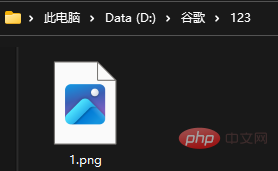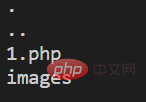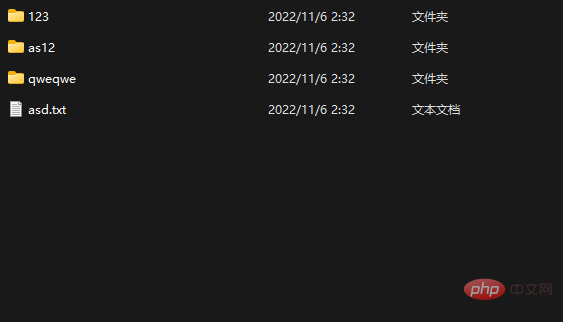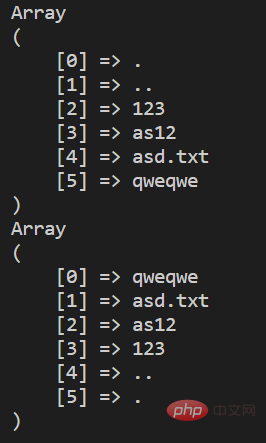 Backend Development
Backend Development
 PHP Tutorial
PHP Tutorial
 This article will take you through file and directory operations in PHP
This article will take you through file and directory operations in PHP
This article will take you through file and directory operations in PHP
How does PHP perform file and directory operations? The following article will give you an in-depth understanding of HP file and directory operations. I hope it will be helpful to you!

Path and disk operations
Relative path and absolute path
Absolute path: The path where the drive letter of the current file is located is the starting point
For example:
For example, picture 1.png
The absolute path of this picture is
D:\Google\123\1.png
Let’s explain the content represented by this string of paths separately
- D: (referring to the drive letter
- \ (the one with the table is the directory separator
- Tip: (windows operating system Supports forward slashes and backslashes, other systems support forward slashes /, so forward slashes can reduce compatibility issues)
Relative path: With the location of the file to be operated on The directory is the starting path
This is a
relative concept, different reference objects write different paths
Why do you say that
Let’s give an example:
Suppose we use 1.png as a reference


- ##1.txt
./1.txt
(There is a dot before 1.)2.txt-
Explain it../2.txt
(two dots before 2)1.txt is - a file in the same directory, so only one dot is needed in front, and this dot represents the current directory 2.txt is the
- lower directory, 1.png is the upper directory of 2.txt, the two dots here represent the upper directory
- believe it Everyone already knows about relative paths and absolute paths
Getting file path information
We need to understand it first Some concepts
Path:
/love/xianyu.txt
- Directory name (dirname ) is /love
- with the file extension name (basename) being xianyu.txt
- the extension name (extension) being .txt
- the file name (filename) being xianyu
Enter the text below
pathinfo()
In order to obtainSpecified path and file name
, you can use thepathinfo()function, this function will return anassociative array
1
2
3
4
5
6
7
8
9
10
11
12
13
14
<?php
$xianyu="/love/xianyu.php";
$result=pathinfo($xianyu);
foreach($resultas$key=>$value){
echo"$key=>$value\n";
}
?>
/*
输出:
dirname=>/love
basename=>xianyu.php
extension=>php
filename=>xianyu
*/Copy after login
Quickly obtain the file name: basename()
##basename()Function,
Quickly obtain thefile namepart of the specified filewithout reading from thearray
1
2
3
4
5
6
7
<?php
$xianyu="/love/xianyu.php";
echo$filepath."中的文件名是:".basename($xianyu);
?>
/*
中的文件名是:xianyu.php
*/Copy after login
Quickly obtain the directory part of the path: dirname()
Use thedirname()function to
quickly obtain it Specify thedirectorypart of the specified file
1
2
3
4
5
6
7
<?php
$filepath="/love/xianyu.php";
echo$filepath."中的路径部分是:". dirname($filepath);
?>
/*
/love/xianyu.php中的路径部分是:/love
*/Copy after login
Directory operation
Opening and closing directories
Handle:
- opendir(), closedir()
return valueOpen the images directory. With the handle, you can operate on the open directory
1
2
3
4
5
6
7
8
9
10
11
12
<?php
$dir="images";
if($dir_handle= opendir($dir))
{
echo"获取目录句柄成功!";
closedir($dir_handle);//记得释放句柄
}
else
{
echo"打开目录错误";
}
?>Copy after login


- Why release the handle? If you don't release the handle, it's like you and a bunch of people are writing in a notebook. If you take it away and don't put it back, others can't write. So releasing the handle can save server resources
readdir()
scandir()
fopen(), fclose()
fread(), file_get_contents(), file()
fwrite(), file_put_contents()
unlink()
copy()
rename()
创建目录
1 2 3 |
|
删除目录
1 2 3 |
|
获取当前工作目录
1 2 3 |
|
改变当前工作目录
1 2 3 4 5 |
|
获取目录句柄条目
将一个参数名作为参数传递给函数
readdir(),这个函数能返回目录下所有子目录和文件
注意:调用一次返回一个!!
1 2 3 4 5 6 7 8 |
|

读取目录条目
直接返回
指定目录下的文件和子目录,并且按照要求排序(默认字母升序)
1 2 3 4 5 6 |
|


文件操作
操作文件的一般步骤即:打开,读取或写入,关闭
由于目录和文件本质上都属于文件,除了使用函数不同,很多操作都是相通的
判断文件是否存在
1 2 3 4 5 6 7 |
|
创建,打开,关闭文件
1 2 3 4 5 6 7 8 9 10 11 12 13 14 15 |
|
读取文件
1 2 3 4 5 6 7 8 9 10 |
|
写入文件
1 2 3 4 5 6 7 8 9 |
|
删除文件
1 2 3 4 |
|
复制文件
1 2 3 4 5 |
|
移动,重命名文件或目录
1 2 3 4 5 6 7 8 9 |
|
推荐学习:《PHP视频教程》
The above is the detailed content of This article will take you through file and directory operations in PHP. For more information, please follow other related articles on the PHP Chinese website!

Hot AI Tools

Undresser.AI Undress
AI-powered app for creating realistic nude photos

AI Clothes Remover
Online AI tool for removing clothes from photos.

Undress AI Tool
Undress images for free

Clothoff.io
AI clothes remover

Video Face Swap
Swap faces in any video effortlessly with our completely free AI face swap tool!

Hot Article

Hot Tools

Notepad++7.3.1
Easy-to-use and free code editor

SublimeText3 Chinese version
Chinese version, very easy to use

Zend Studio 13.0.1
Powerful PHP integrated development environment

Dreamweaver CS6
Visual web development tools

SublimeText3 Mac version
God-level code editing software (SublimeText3)

Hot Topics
 1391
1391
 52
52
 PHP 8.4 Installation and Upgrade guide for Ubuntu and Debian
Dec 24, 2024 pm 04:42 PM
PHP 8.4 Installation and Upgrade guide for Ubuntu and Debian
Dec 24, 2024 pm 04:42 PM
PHP 8.4 brings several new features, security improvements, and performance improvements with healthy amounts of feature deprecations and removals. This guide explains how to install PHP 8.4 or upgrade to PHP 8.4 on Ubuntu, Debian, or their derivati
 7 PHP Functions I Regret I Didn't Know Before
Nov 13, 2024 am 09:42 AM
7 PHP Functions I Regret I Didn't Know Before
Nov 13, 2024 am 09:42 AM
If you are an experienced PHP developer, you might have the feeling that you’ve been there and done that already.You have developed a significant number of applications, debugged millions of lines of code, and tweaked a bunch of scripts to achieve op
 How To Set Up Visual Studio Code (VS Code) for PHP Development
Dec 20, 2024 am 11:31 AM
How To Set Up Visual Studio Code (VS Code) for PHP Development
Dec 20, 2024 am 11:31 AM
Visual Studio Code, also known as VS Code, is a free source code editor — or integrated development environment (IDE) — available for all major operating systems. With a large collection of extensions for many programming languages, VS Code can be c
 Explain JSON Web Tokens (JWT) and their use case in PHP APIs.
Apr 05, 2025 am 12:04 AM
Explain JSON Web Tokens (JWT) and their use case in PHP APIs.
Apr 05, 2025 am 12:04 AM
JWT is an open standard based on JSON, used to securely transmit information between parties, mainly for identity authentication and information exchange. 1. JWT consists of three parts: Header, Payload and Signature. 2. The working principle of JWT includes three steps: generating JWT, verifying JWT and parsing Payload. 3. When using JWT for authentication in PHP, JWT can be generated and verified, and user role and permission information can be included in advanced usage. 4. Common errors include signature verification failure, token expiration, and payload oversized. Debugging skills include using debugging tools and logging. 5. Performance optimization and best practices include using appropriate signature algorithms, setting validity periods reasonably,
 How do you parse and process HTML/XML in PHP?
Feb 07, 2025 am 11:57 AM
How do you parse and process HTML/XML in PHP?
Feb 07, 2025 am 11:57 AM
This tutorial demonstrates how to efficiently process XML documents using PHP. XML (eXtensible Markup Language) is a versatile text-based markup language designed for both human readability and machine parsing. It's commonly used for data storage an
 PHP Program to Count Vowels in a String
Feb 07, 2025 pm 12:12 PM
PHP Program to Count Vowels in a String
Feb 07, 2025 pm 12:12 PM
A string is a sequence of characters, including letters, numbers, and symbols. This tutorial will learn how to calculate the number of vowels in a given string in PHP using different methods. The vowels in English are a, e, i, o, u, and they can be uppercase or lowercase. What is a vowel? Vowels are alphabetic characters that represent a specific pronunciation. There are five vowels in English, including uppercase and lowercase: a, e, i, o, u Example 1 Input: String = "Tutorialspoint" Output: 6 explain The vowels in the string "Tutorialspoint" are u, o, i, a, o, i. There are 6 yuan in total
 Explain late static binding in PHP (static::).
Apr 03, 2025 am 12:04 AM
Explain late static binding in PHP (static::).
Apr 03, 2025 am 12:04 AM
Static binding (static::) implements late static binding (LSB) in PHP, allowing calling classes to be referenced in static contexts rather than defining classes. 1) The parsing process is performed at runtime, 2) Look up the call class in the inheritance relationship, 3) It may bring performance overhead.
 What are PHP magic methods (__construct, __destruct, __call, __get, __set, etc.) and provide use cases?
Apr 03, 2025 am 12:03 AM
What are PHP magic methods (__construct, __destruct, __call, __get, __set, etc.) and provide use cases?
Apr 03, 2025 am 12:03 AM
What are the magic methods of PHP? PHP's magic methods include: 1.\_\_construct, used to initialize objects; 2.\_\_destruct, used to clean up resources; 3.\_\_call, handle non-existent method calls; 4.\_\_get, implement dynamic attribute access; 5.\_\_set, implement dynamic attribute settings. These methods are automatically called in certain situations, improving code flexibility and efficiency.



